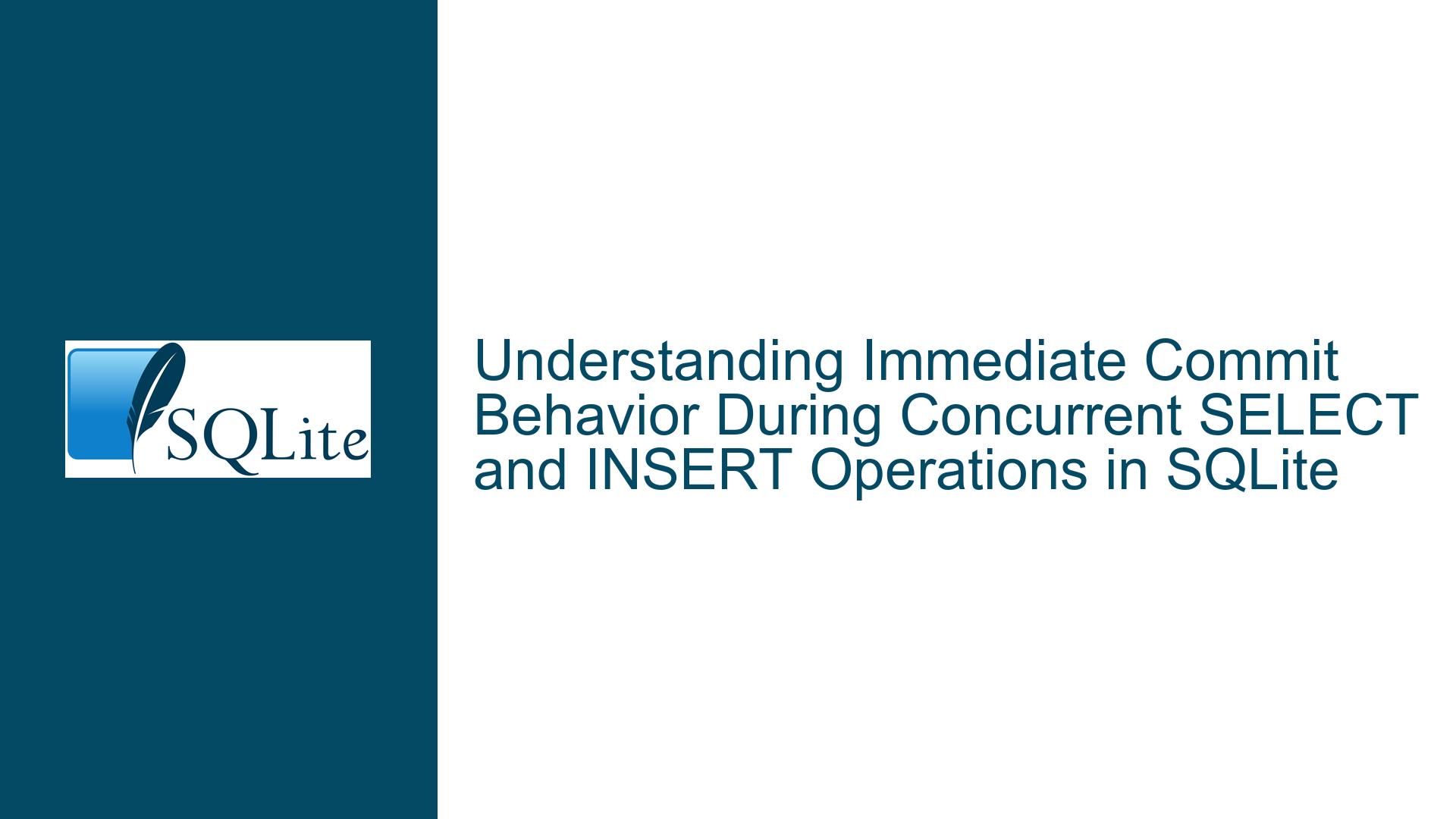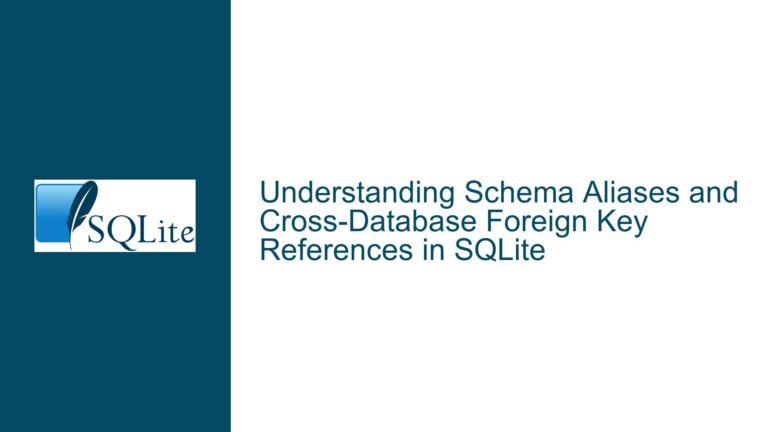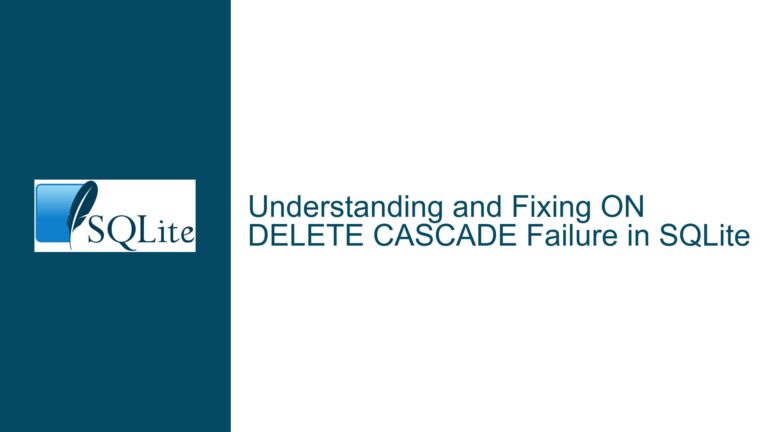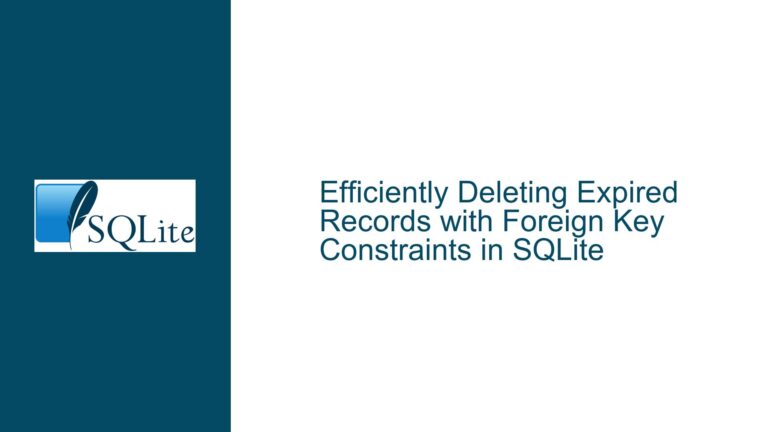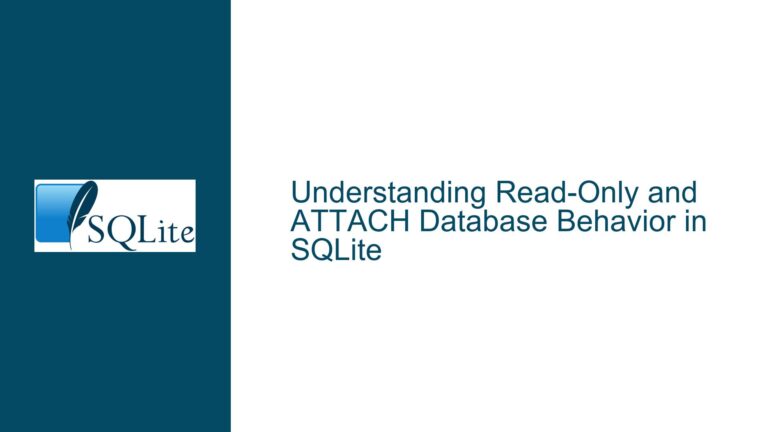Immediate Commit Behavior During Concurrent SELECT and INSERT Operations in SQLite
Issue Overview: Contradiction Between Documented and Observed Autocommit Behavior During Mixed Read/Write Operations
The core issue revolves around a discrepancy between historical SQLite documentation and the observed behavior when executing INSERT operations on one table while iterating through the results of a SELECT query on another table using the same database connection. The documentation previously stated that autocommit would be deferred until all active commands (including the SELECT) completed. However, practical testing reveals that INSERT operations are committed immediately, even while the SELECT query is still actively processing rows. This creates confusion regarding transaction boundaries, data visibility, and the atomicity of operations when mixing reads and writes on the same connection.
To understand the problem, consider the following scenario:
- A single SQLite database connection is opened with autocommit mode enabled (the default behavior).
- A SELECT query is executed on Table A, and the application iterates through the result set row by row.
- During iteration, the application performs INSERT operations on Table B using the same connection.
According to outdated documentation, all changes made by the INSERT operations should remain uncommitted until the SELECT query finishes. However, in reality, each INSERT is committed to the database immediately after execution. External database clients monitoring the "write" table will observe new rows appearing incrementally as the SELECT loop progresses. This behavior has significant implications for:
- Data Consistency: Other processes may act on partially inserted data before the SELECT completes.
- Error Recovery: Rolling back all changes in case of mid-loop failures becomes impossible without explicit transaction control.
- Concurrency: Write operations may block other connections depending on the journaling mode (rollback vs. WAL).
The contradiction arises from changes made to SQLite’s transaction handling in version 3.6.5 (2008), which were not fully reflected in all documentation sections. The autocommit deferral mechanism described in older documentation no longer applies to mixed read/write workloads on the same connection. Instead, each write operation executes in its own implicit transaction unless explicitly wrapped in a multi-statement transaction block.
Possible Causes: Historical Documentation Inaccuracies and Transaction Handling Changes
Three primary factors contribute to the observed behavior:
1. Outdated Documentation on Autocommit Deferral
The removed documentation paragraphs from lockingv3.html incorrectly described autocommit behavior for multi-statement operations. Prior to SQLite 3.6.5, the database engine deferred committing transactions until all active statements completed. This allowed applications to batch multiple changes across different tables while a SELECT was in progress, with all modifications committing atomically at the end. However, this behavior was modified to improve concurrency and reduce the scope of implicit transactions.
2. Transaction Scope Changes in SQLite 3.6.5
Version 3.6.5 introduced critical changes to how SQLite manages transactions:
- Implicit Per-Statement Transactions: Each INSERT/UPDATE/DDELETE statement automatically starts and commits a transaction unless explicitly wrapped in BEGIN…COMMIT.
- Read Transaction Upgrades: A SELECT statement starts a read transaction that automatically upgrades to a write transaction when a modifying operation occurs.
- Statement Journaling: For rollback journal mode, each statement creates a temporary journal that rolls back if the statement fails, without affecting other statements.
These changes mean that while iterating through a SELECT result set:
- The initial SELECT creates a read transaction.
- The first INSERT upgrades this to a write transaction.
- The write transaction commits immediately after the INSERT completes (in autocommit mode).
- Subsequent INSERTs create new write transactions.
3. Journal Mode Misunderstandings
The original issue report tested both rollback and WAL journal modes, observing identical commit behavior. This occurs because the critical factor is transaction scope management rather than journaling mechanics:
- Rollback Journal Mode: Requires exclusive write locks during modification. The same connection can upgrade its read lock to a write lock without releasing it between statements.
- WAL Mode: Allows concurrent readers and a single writer. Write transactions append to the WAL file but don’t block readers.
In both modes, autocommit transactions from the same connection commit independently of ongoing read operations. External connections may observe differences in when changes become visible (WAL’s write-after-read semantics vs. rollback’s exclusive locking), but the committing application will always see its own changes immediately due to connection-local cache coherence.
Troubleshooting Steps, Solutions & Fixes: Managing Transaction Boundaries in Modern SQLite
Step 1: Verify SQLite Version and Documentation Sources
Confirm that the observed behavior aligns with modern SQLite versions (3.6.5+):
sqlite3 --version
Cross-reference documentation against the official versioned docs, as general documentation pages may not cover historical behavior changes.
Step 2: Understand Autocommit and Explicit Transactions
SQLite operates in autocommit mode unless a transaction is explicitly started with BEGIN. To replicate the old deferred commit behavior:
// C++ example using explicit transaction
sqlite3_exec(db, "BEGIN", 0, 0, 0);
while((rc = sqlite3_step(select)) == SQLITE_ROW) {
// Perform INSERTs
}
sqlite3_exec(db, "COMMIT", 0, 0, 0);
This ensures all INSERTs and the SELECT execute atomically. The tradeoff is that the write lock is held for the entire operation, blocking other writers.
Step 3: Choose Appropriate Journal Modes
For High Concurrency:
PRAGMA journal_mode = WAL;
WAL mode allows concurrent reads while a write is in progress. Changes become visible to other connections after the write transaction commits, but the writing connection sees changes immediately.
For Atomic Bulk Operations:
PRAGMA journal_mode = DELETE; -- Default rollback journal
BEGIN;
-- Perform multiple writes
COMMIT;
Rollback journal mode provides stricter atomicity guarantees when using explicit transactions, as the entire database file is updated atomically on COMMIT.
Step 4: Monitor Transaction State Programmatically
Use sqlite3_get_autocommit() to check if the connection is in autocommit mode:
int autocommit = sqlite3_get_autocommit(db);
printf("Autocommit state: %d\n", autocommit); // 1 = autocommit, 0 = in transaction
In Python, check via the connection’s in_transaction property:
print(db.in_transaction) # True if inside a transaction
Step 5: Handle Statement Interactions Carefully
When mixing SELECT and INSERT on the same connection:
- Reset or Finalize Statements Promptly:
Always callsqlite3_reset()orsqlite3_finalize()on completed statements to release locks. - Avoid Interleaved Writes to Read Tables:
Writing to a table being read can trigger the Halloween Problem, where modifications affect subsequent query results. Use separate connections for read/write if modifying the same table.
Step 6: Implement Error Handling for Transaction Collisions
Even with WAL mode, certain operations may return SQLITE_BUSY if the database is locked. Use a retry loop with exponential backoff:
int retries = 5;
while (retries-- > 0) {
rc = sqlite3_step(insert_stmt);
if (rc == SQLITE_BUSY) {
usleep((1 << (5 - retries)) * 1000); // Exponential backoff up to 32ms
continue;
}
break;
}
Step 7: Profile Transaction Performance
Use PRAGMA temp_store = MEMORY; and PRAGMA cache_size = -kibibytes; to optimize transaction speed. Monitor performance with:
PRAGMA compile_options; -- Check for debugging features
PRAGMA integrity_check; -- Verify database health
EXPLAIN QUERY PLAN INSERT INTO write VALUES(?); -- Analyze insert performance
Final Recommendation
To achieve deterministic commit behavior:
- Use explicit BEGIN/COMMIT for atomic multi-statement operations.
- Prefer WAL mode for concurrent read/write workloads.
- Separate read-heavy and write-heavy operations to different connections when possible.
- Regularly consult the official SQLite documentation for updates on transaction isolation and locking.
By understanding these mechanisms, developers can leverage SQLite’s flexible transaction model while avoiding pitfalls from outdated documentation assumptions.
